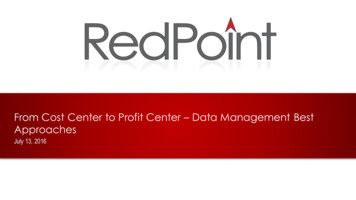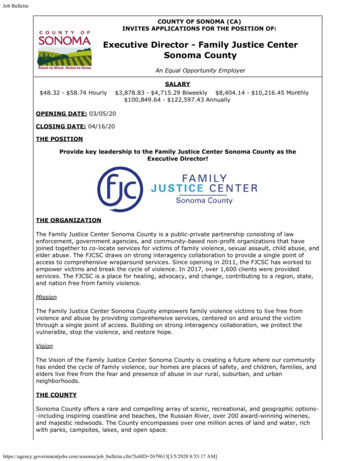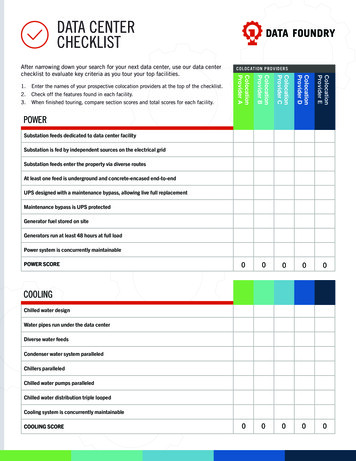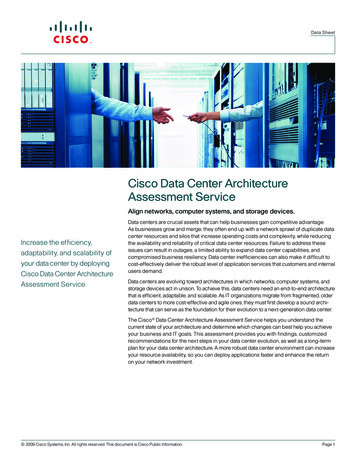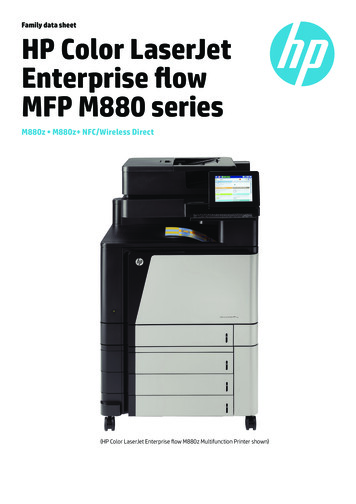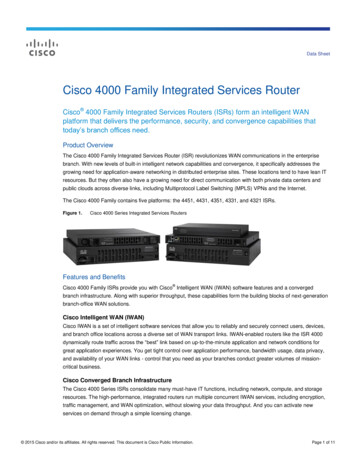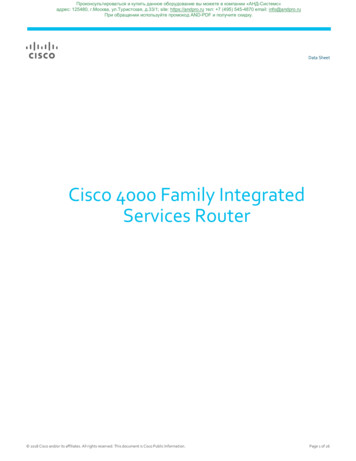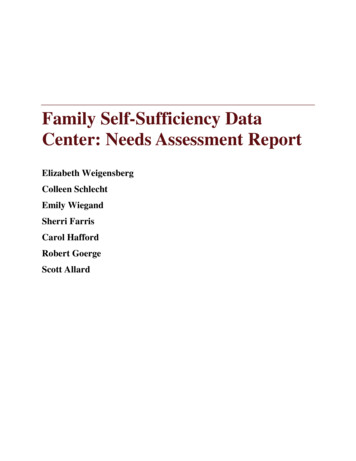
Transcription
Family Self-Sufficiency DataCenter: Needs Assessment ReportElizabeth WeigensbergColleen SchlechtEmily WiegandSherri FarrisCarol HaffordRobert GoergeScott Allard
Report to the U.S. Department of Health and Human Services,Administration for Children and Families, Office of Planning,Research and Evaluation Award #90PD0272Family Self Sufficiency Data Center,Principal Investigators:Robert Goerge, PIScott Allard, Co-PI
Family Self-Sufficiency Data Center: Needs Assessment ReportElizabeth Weigensberg, Colleen Schlecht, Emily Wiegand, Sherri Farris, and Carol HaffordRecommended CitationWeigensberg, E., Schlecht, C., Wiegand, E., Farris, S., Hafford, C., Goerge, R., & Allard, S. (2014).Family Self-Sufficiency Data Center: Needs Assessment Report. Chicago: Chapin Hall at theUniversity of Chicago. 2014 by Chapin Hall at the University of Chicago1313 East 60th StreetChicago, IL 60637ISSN:1097-3125
AcknowledgmentsThe Family Self-Sufficiency Data Center needs assessment and report were supported by funding fromthe U.S. Department of Health and Human Services, Administration for Children and Families, Office ofPlanning, Research and Evaluation. Much appreciation is offered to the numerous state and local publicagency administrators, researchers, and other professionals who provided input through our needsassessment process. Thanks are also due to Bob Goerge, Scott Allard, Tim Mulcahy, Pat Ruggles,Catherine Ruggles, Matt Borus, and Michelle Derr who provided input and feedback throughout theprocess.
Table of ContentsExecutive Summary . 1Definition and Concept of Family Self-Sufficiency . 2The Use of FSS Data . 2Purpose of FSS Data Use . 2Capacity to Use FSS Data . 2Data Use and Sources . 3Longitudinal and Linked Data. 4Data by Source . 4Data Quality. 5Research Needs . 6Feedback for the FSS Data Center . 7Better Use of Data . 7The Role of the Data Center . 7Technical Assistance, Training, and Peer Engagement. 7Potential Implementation Challenges . 7Translating Findings into Actionable Steps. 8Next Steps. 8Introduction . 9Family Self-Sufficiency Data Center . 9Needs Assessment Overview. 10Topics Included in Family Self-Sufficiency. 10Current Use of Data and Research . 10Data and Assistance Needs. 10Methods . 12Sample . 12Focus Groups. 13Interviews . 13Analysis . 13Concept of Family Self-Sufficiency . 14Defining Family Self-Sufficiency . 14
Overview of the Use of Family Self-Sufficiency Data . 17FSS Data Used for Reporting and Performance Management . 17FSS Data Used for Research . 19Capacity and Challenges Using FSS Data . 19Agency Staff Capacity to Use Data . 19Agency Data Use Capacity. 22Data by Type . 25Longitudinal and Linked Data . 25Longitudinal Data . 25Linked Data . 26Data by Source . 27TANF Data . 27Food Assistance Data . 29Unemployment Insurance, Earnings, and Employment Data. 29Medicaid and Health Data . 32Education and Training Data . 34Child Care Subsidy and Child Support . 35Child Welfare . 36Criminal and Juvenile Justice Data . 37Earned Income Tax Credit and Tax Data . 37Census and National Survey Data . 38Original Data Collection . 38Other Data . 40Data Quality . 41Data Entry and Accuracy Concerns. 41Incomplete Data . 42Understanding the Context of Data Collection. 42Timeliness. 43Addressing Quality Concerns . 43Research and Data Needs. 45Research Questions . 45
Data and Tools Needed to Address Research Questions . 47Data Needed . 47Tools Needed. 48Feedback for the FSS Data Center . 49Better Use of Data in FSS . 49Role for the Data Center . 50Training and Technical Assistance . 52Implementation Challenges . 53Other Aspects . 54Implications and Takeaways for Informing the Data Center . 56Translating Findings into Actionable Steps. 56Data Access and Permissions . 57Scope and Types of FSS Data . 57Data Security, Storage and Documentation. 58Data Management, Linking, and Analysis . 58Training and Technical Assistance. 59Promote Peer Engagement . 60Next Steps and Timeline . 60
List of TablesTable 1. Summary of FSS data use and accessibility among Needs Assessment interviewees . 5
Executive SummaryThe Family Self-Sufficiency (FSS) Data Center is funded by the U.S. Department of Health and HumanServices, Administration for Children and Families, Office of Planning, Research and Evaluation. TheData Center’s primary goal is to enhance the use of administrative and survey data to answer policyrelevant questions surrounding family self-sufficiency and well-being. The Data Center pursues this goalby working to increase the amount and quality of data available for FSS research. In addition to makingexisting and new data sources easier to access, the Data Center will work with policymakers andresearchers to ensure data can be stored and analyzed in a secure environment. The Data Center willprovide an empirical, data-driven research platform for researchers, policymakers, and administrators touse in answering fundamental policy and program questions, and will build knowledge that willultimately be translated into better policy and practice.The objective of the needs assessment is to obtain input from key stakeholders—primarily from potentialData Center users—regarding their current capacity, challenges, and needs with FSS data in order to learnhow the Data Center can help meet those needs. Specifically, the needs assessment solicited informationin three areas: (1) the topics included in FSS, (2) the current use of data and research around FSS, and (3)the data and assistance needed among the FSS data user community.To achieve the objective of the needs assessment, the team conducted interviews and focus groups withkey FSS stakeholders, including program administrators, researchers, and other interested groups, such asprofessional associations and advocacy groups. Most interviews were conducted via telephone, whilethe focus groups were conducted in person. Interviews and focus groups took place betweenFebruary and May 2014. A total of 96 people participated in either an interview or a focus group.Chapin Hall at the University of Chicago1
Definition and Concept of Family Self-SufficiencyOur interview respondents defined FSS in different ways. The needs assessment attempted to capture acomplete picture of the diversity around the concept of FSS that is in use among administrators,researchers, and other data users. It also attempted to explore the interviewees’ notions of how FSS can beshaped by local and familial context. Interviewees included the following topics and program areas intheir definitions of FSS: Temporary Assistance for Needy Families (TANF), the Supplemental NutritionAssistance Program (SNAP) and other food assistance programs, Unemployment Insurance, child caresubsidies, housing supports, job training, the Earned Income Tax Credit (EITC), Medicaid and healthservices, education, child welfare, criminal justice, domestic violence, substance abuse, economic andcommunity development, transportation, and assets. More broadly, FSS is characterized by incomesupplements, work supports, and a variety of areas that contextualize families’ financial stability andgeneral well-being. Knowledge of these contextual factors allows analysts, case managers, andresearchers to better understand what may be shaping observed behaviors and more effectively targetprograms to maximize impact.The Use of FSS DataPurpose of FSS Data UseState and local agency administrators were asked to describe their agencies’ current use of FSS data. Theydescribed a wide array of applications representing varying degrees of sophistication in data use.Agencies use data for reporting, performance management, and quality control purposes includingfederally mandated reporting, internal metrics or scorecards, and fraud prevention and program integritywork. A small number of agencies also use data internally to answer research questions that inform policyplanning, generally by helping to understand the impact of a new or proposed policy change. Morecommonly, state and local administrators interviewed mentioned undertaking partnerships with externalresearchers or organizations to fully utilize the data that can address their FSS questions and populations.These partnerships focused on evaluating programs, understanding populations, and estimating policyimpacts.Capacity to Use FSS DataHow agencies and researchers use data is determined not only by what they seek to know but, perhapsmore importantly, by their ability to access and analyze the necessary data. Interviewees provideddramatically different accounts of state and local agencies’ capacity to use data. About one-third ofadministrators interviewed described having dedicated research or evaluation staff members within theiragency. Another one-third of administrators came from agencies with no formal research staff, but whereChapin Hall at the University of Chicago2
one or more staff members are dedicated to data management or reporting. A handful of intervieweesdescribed organizations that lack even that capacity. In these agencies, program staff and administratorsdo their own reporting or data analysis, depending on their time, skill, and inclination. Data managementand reporting in these agencies often falls on the IT staff.In their work, interviewees indicated they addressed wide-ranging research and performance managementquestions. This requires access to datasets from multiple agencies in many areas, and requires that thedata be shared and integrated. Some elements present in state and local agencies aid administrators andresearchers in access, sharing, and data use, while others serve as additional barriers to these functions.Administrators and researchers described successful collaborations and data sharing arrangements andthey repeatedly emphasized the importance of relationships in making these arrangements work to aiddata sharing and access. Organizations that work together frequently and perform mutually beneficialwork tend to have less trouble negotiating data sharing agreements. Additionally, having clear datasharing policies typically facilitates the sharing of data across departments.Legal restrictions are a particular challenge in sharing data. Several interviewees mentioned the difficultyin obtaining permissions to share their own data, working through data sharing agreements, and obtainingconsent in accessing data from other agencies. State data sharing policies, even for sharing betweendepartments in the same state, are often unclear or, if clear, extremely stringent. Restrictions on sharingdata that contains identifiers are even stricter, which increases the difficulty of combining data frommultiple sources.Resource limitations, including limited staff or system capacity, also impact the possibility of datasharing. If the agency lacks the resources or technical ability to extract the necessary data, sharing is notpossible. Additionally, even after the data is shared, staff time is needed to answer questions forresearchers who lack knowledge of the agency or it
The Family Self-Sufficiency Data Center needs assessment and report were supported by funding from the U.S. Department of Health and Human Services, Administration for Children and Families, Office of Planning, Research and Evaluation. Much appreciation is




